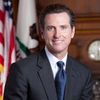What comes to mind when you hear the phrase "green building?" Sleek new structures with skins of advanced glass and recycled steel that blend into the landscape, facades and roofs draped in a combination of daylight-harvesting windows, wildlife habitat, and photovoltaics? New construction affords the flexibility to build contemporary masterpieces, like the California Academy of Sciences, which will receive its LEED Platinum certification this morning in San Francisco. The museum will be the largest and most visited LEED Platinum building in the world.
The Academy of Sciences is a breathtaking example of our city and our citizens' efforts to address the fact that roughly half of all greenhouse gas emissions in San Francisco are attributable to our buildings. In August of 2008, I signed a groundbreaking green building ordinance that created the most stringent green building requirements in the nation. This was a big step in the right direction, requiring that all new buildings be subject to an unprecedented level of LEED and green building certifications. However, a comprehensive recipe for our environmental and economic sustainability requires solutions to the challenges posed by existing buildings.
New construction is essential to the vitality of a city, but it's important to note that most of the San Francisco of the future has already been built. New construction typically represents less than one percent of San Francisco's built environment in any given year. In contrast, more than half of commercial buildings in San Francisco were constructed before 1978, when the state adopted Energy Efficiency Standards - requiring far more energy than those built afterwords. By retrofitting our existing structures there is the potential to create thousands of green jobs.
Greening existing buildings is more challenging than new construction. Consider that buildings use two thirds of our state's electricity. While per capita electricity use in California has remained consistent for decades, total energy use continues to increase by 1.5 percent per year. Existing buildings are diverse in their size, vintage, use, and resources available for maintenance and improvements. In a tough economy, vacancy in commercial real estate is increasing nationwide - but the vacancy rate in LEED certified commercial office space in San Francisco is less than half that of standard office space.
To address these challenges and opportunities, I've convened an Existing Buildings Efficiency Task Force comprised of members from San Francisco's ownership, developer, financial, architectural, engineering, and construction community. With the aid of this Task Force, the city will partner with the private sector to enable, encourage, and in some cases require that cost-effective opportunities to cut energy consumption 20% to 50%, improve water efficiency, and continue to move toward the elimination of solid waste in our community.
The Task Force builds upon a great deal of work we're doing already - taking full advantage of the $7-$11 million provided in Energy Efficiency Block Grants provided by the federal stimulus, leveraging our ongoing $6.7 million a year energy efficiency partnership with PG&E, and working with private partners to create a San Francisco Clean Energy Fund. Each of these efforts creates hundreds of green jobs retrofitting our existing building stock, and in the process reduces utility costs and environmental impacts, making San Francisco a more competitive place to locate a company and raise a family.
Listen to Mayor Newsom's Green 960 radio show online or subscribe to his weekly policy discussions on iTunes. Join Mayor Newsom on Facebook. You can also follow him on Twitter.
